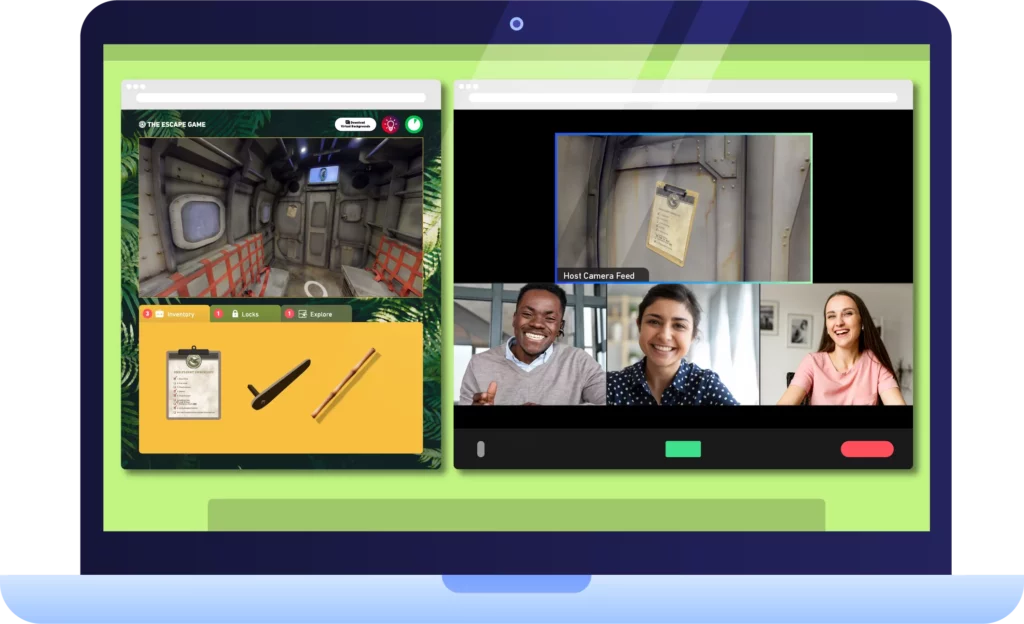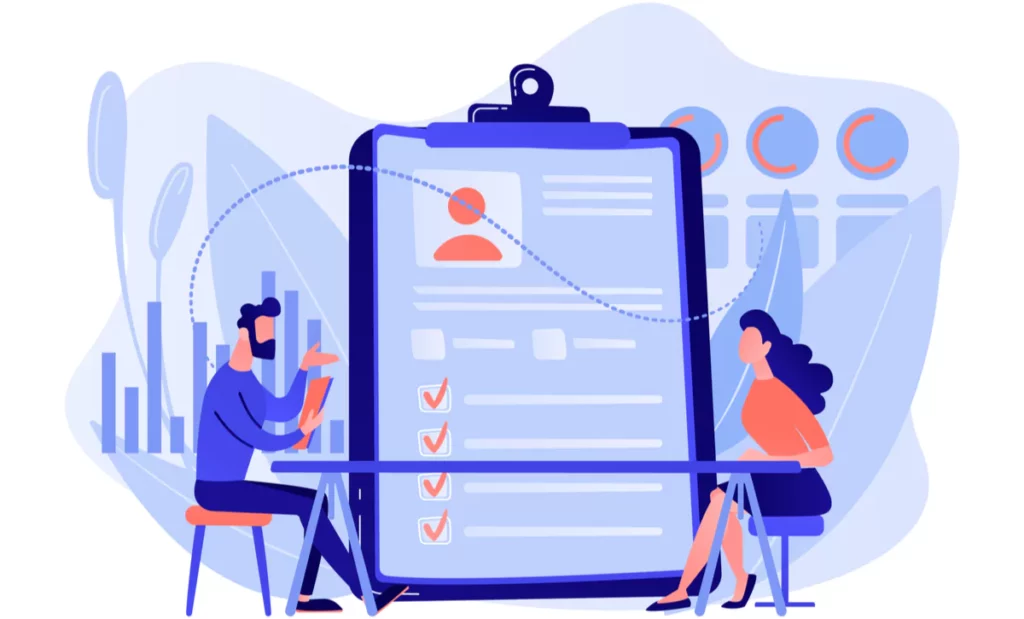Based on its 50 years of studying employee engagement, Gallup has emphatically stated that “engaged employees produce better business outcomes than other employees — across industry, company size and nationality, and in good economic times and bad.” An in-depth scholarly review on the topic found that engaged employees “are more productive, profitable, safer, healthier, and less likely to leave their employer”. In 2017, Gallup’s State of the American Workplace found that engaged employees could raise a company’s productivity level by as much as 200% over similar organizations with disengaged employees. Statistics like this make it nearly impossible to dispute that employee engagement plays a critical role in an organization’s success!
But employee engagement doesn’t happen on its own. It needs to be nurtured and continually improved upon. HR employee engagement activities like team building exercises and games can keep your employees engaged and strong contributors to your company’s success.
Table of Contents
Why Is Team Building Important For Your Team?
How HR Can Affect Employee Engagement
16 HR Team Building Activities For Employee Engagement

Why Is Team Building Important For Your Team?
Employee engagement and team building are integral elements of any successful business. Disengaged employees have no attachment to their job or their employer. They feel under appreciated and withhold their energy and creativity from the team. At their worst, a disengaged employee may be disruptive to the team and undermine the team’s functionality. As an HR professional, it is your job to find ways to address the lack of engagement in an employee and, in some cases, entire teams or departments.
Team building is important for your team because it can increase engagement in employees who have ‘checked out’. Team building activities embed key drivers of employee engagement in your company culture. For each of these drivers below, there are team building activities that address them.
Recognition
Among the top drivers of employee engagement is recognition. Employees want to feel valued, and not just monetarily. Companies who show their employees that they are truly appreciated can boost employee engagement and also retention rates. Gallup found that “employees who do not feel adequately recognized are twice as likely to say they’ll quit in the next year”. There are team building games and events that center around recognition and appreciation.
Strong Relationships
One study found that employees are more likely to be engaged if they have positive relationships with colleagues. This notion is supported by a white paper by the National Business Research Institute that states “quality friendships in the workplace have a direct link to employee engagement and job satisfaction.”
Team building activities afford co-workers the chance to get to know one another better and develop meaningful connections. They build trust amongst the team and individuals feel a sense of belonging. These connections have a positive effect on employee engagement.
Growth Opportunities
All employees have strengths and weaknesses. While your company may offer training to overcome any skill deficits, team building activities are often a more enjoyable way for employees to strengthen their weak skills. At the same time, team building activities also let employees use their talents, especially those that don’t always play a part in their work.
Good Communication
Poor communication among team members can derail group productivity. Ineffectual discussions and frequent misunderstandings lead to more problems and fewer solutions. Team building activities are a platform to improve communication. Many team building games aim specifically to improve communication. Also, some team building activities require input from everyone thereby inviting quieter team members to vocalize their thoughts in a low-pressure environment.
Collaboration
Statistics show that 75% of employers regard collaboration as “very important” and 33% of HR professionals believe that collaboration has a direct impact on employee morale. Yet less than half of employees worldwide felt there isn’t enough collaboration in their workplace. Most team building activities involve collaboration to a great extent as they strive to help teams become cohesive.

How HR Can Affect Employee Engagement
Building a cohesive team comes with the following employee engagement.
Lack of Trust
In an HR.COM survey, 80% percent of HR professionals replied that employee engagement is linked to trust in leadership. Creating a culture of trust at all levels is one way to prevent employees from becoming disengaged.
Poor Communication
When employers fail to adequately communicate to employees the information they need to do their jobs well, disengagement may follow. On the other hand, by allowing a free flow of communication where feedback and input are welcome, employees feel heard and become more engaged in their jobs.
Absence of Collaboration
When teams collaborate by sharing ideas and skills, individual team members feel connected to each other and feel part of something bigger than themselves. This leads to higher employee engagement and better team unity.
Non-participative Leadership
When management invites the entire team to participate in decision-making, employees feel that their voice matters. This style of leadership offers employees an opportunity to practice their leadership skills. Room to grow is one of the top drivers of employee engagement.
The above challenges to forming a strong cohesive team can be overcome with the use of team building activities and games. Team building activities are designed to increase collaboration and improve communication. They foster satisfying relationships and trust among team members. Team building activities present opportunities for growth and development. They can also be a whole lot of fun! HR activities for employee engagement are worth investing in if you want to keep your employees engaged and your teams productive.
16 HR Team Building Activities For Employee Engagement
Here are 16 employee engagement activities that can be run by HR. These activities will spark employee engagement, develop team cohesion, and leave your team members feeling great about being part of your company. Most of these activities are good for small to medium-size businesses. Some, like outdoor activities, work well with large organizations. Nearly every activity and game can be adapted for remote or hybrid workplaces.
1. Hold An Awards Ceremony
One of the top drivers of employee engagement recognition. As American psychologist William James said, “The deepest principle in human nature is the craving to be appreciated.” An awards ceremony lets your team members know that they are valued for their hard work. Hand out awards for “Best Team Player” or “Stand out Performer”.
Acknowledging your employees’ talents impacts more than just the award recipient. A culture of recognition increases employee loyalty and promotes morale. You can also easily host this activity virtually if you’re a remote or hybrid team. Here are an additional 22 employee appreciation ideas to let team members know how much they are valued.
2. Celebrate Milestones
Celebrating individual accomplishments or personal milestones is a step beyond naming someone “salesperson of the year”. Holding an anniversary party shows team members that you remember what day and year they joined the company and that is a powerful message of appreciation. Other occasions to celebrate are birthdays, promotions, retirements, as well as company milestones like landing a big client. Remote teams can also celebrate big occasions together. Virtual company celebrations are one of the best HR team building activities for virtual teams.

3. Escape Rooms
Escape room team building is a thrilling activity that can enhance your team’s unity and encourage employee engagement. These immersive hour-long games challenge teams to work to decipher clues, solve puzzles and “escape the room” before it’s too late! Drawing on problem-solving, creative thinking, collaboration, and communication, escape rooms let your team work on these skills in a fun and low-stakes environment. Moreover, collaborative games and activities provide professional growth opportunities, a key driver in employee engagement. Escape room games give everyone the chance to step up as a leader to keep the group focused on the ultimate goal of winning!
If your team is remote or hybrid, virtual escape rooms are just as effective as in-person escape rooms since teams must work together despite the physical distance. Escape rooms, whether played in person or online, are one of the very best leadership activities. Find more virtual escape room options here.
4. Encourage Coffee Breaks
In America, coffee breaks are often taken at one’s desk alone. The Swedish version of a coffee break is known as Fika. Fika is so much more than a quick hello at the office’s coffee machine. It’s about taking a break from work to socialize with colleagues. It’s a time to de-stress and catch up with coworkers about non-work-related things. Fika boosts morale which makes for happier workers. Encouraging breaks throughout the day, rather than frowning upon them, shows that your company values your employees’ well-being.
If your team is remote, coffee breaks are more important! Virtual coffee breaks may be the only time in a remote worker’s day when they interact socially with coworkers, or perhaps anyone! Virtual coffee breaks, as well as virtual water cooler gatherings, help remote teams feel connected and alleviate the isolation that sometimes accompanies working from home. Be sure to schedule virtual coffee breaks and water-cooler chats on your company’s shared calendar!
5. Recruit Onboarding Buddies
Onboarding is the process by which a company integrates a new employee into the organization. Part of onboarding is to help new employees understand their role and begin on-the-job training. While HR and management lead much of the onboarding process, onboarding “buddies” serve an important role. Onboarding buddies are current employees who act as a general resource for new hires. Onboarding buddies help new employees to navigate the company structure and to adapt to company culture. They make introductions and answer questions that won’t be in the company’s handbook.
Clearly, new employees can benefit from having an onboarding buddy. But there are rewards for experienced employees as well! Being an onboarding buddy is an opportunity to develop leadership skills. When making introduction rounds with new hires, onboarding buddies are initiating new connections for themselves. Both the opportunity for growth and developing work relationships contribute to employee engagement.
With so many companies operating remotely, the onboarding process has gone online so even a new remote hire can have a virtual onboarding buddy!
6. Head Outdoors
Show your team that you care about their wellness (a key driver in employee engagement) by heading outside for some fresh air and natural light. Research shows that spending time in nature has both mental and physical health benefits. Being outdoors is a time when your employees can bond with nature and each other. People are more relaxed when away from their desks and are more open to connecting with others. The lack of structure in nature eliminates barriers found in the office that keep people apart and prevent meaningful relationships from forming. If time is not an issue, schedule a hike. Choose a level appropriate for your group’s demographics. If a hike is impractical for your group, based on scheduling and your location, take a stroll instead. Research shows that even 20 minutes in nature can provide a major boost in energy!

7. Trivia Games
Playing trivia games makes people feel good. Not just because they’re fun but because playing trivia causes our bodies to produce more dopamine, the “happy hormone”. Playing trivia allows team members to improve skills like collaboration and decision-making as they work together to find the right answer. Linkee is a trivia game that has players guessing what links the three clues on each game card. For example, if the answers were John, Paul, George, and Ringo, the link would be The Beatles.
Kahoot! is a popular and free online team trivia game that you can even play with an in-person group. Their unique platform allows you to customize the game for your group if you want to. Kahoot also has a business version incorporating some of the benefits of team building into a game format. There are plenty of virtual trivia games for remote teams too!
8. Host A Happy Hour
When teams spend time in a casual setting, talking about non-work-related topics, the more likely it is that they will bond. Team members will begin to feel more comfortable and confident to share ideas or take initiatives back at the office. Work friendships and a sense of belonging are big drivers of employee engagement, so take the team out for a beer! Remote teams can easily have virtual happy hours too!
9. Ice Breakers
Ice breakers are questions to help individuals get to know each other a little bit better. Ice breakers are a great way to start a meeting since they only take a few minutes and they get those creative juices flowing! Examples of basic questions are: “Where did you grow up?” or “Are you a cat person or a dog person?” Questions can be creative, like “Would you visit Mars even if the round trip took a year?” or even silly, like “What band are you embarrassed to admit that you love?” No matter what the question, ice breakers are a great way for team members to learn more about each other in a fun way!
10. Shark Tank-Style Competition
Based on the popular reality TV show, this game challenges teams to develop an innovative service or product which they must convince judges is better than the other teams’ offering. Give teams one hour to design their product, come up with a business plan, write up a marketing plan, and list financial data like predicted profit margins.
After the hour is up, teams pitch their product to a panel of judges made up of other employees, team leaders, and even management. Whichever team wins gets a prize, like a free lunch. The winning team can dine together and laugh about the fun they had together. A Shark Tank-style competition promotes collaboration and communication, encourages out-of-the-box thinking, and develops leadership skills!
11. Ropes Course
A ropes course is an activity for teams who face various physical obstacles that they must overcome together. One example of a ropes course challenge is trying to fit the whole team onto a small elevated platform that appears to only have space for three or four people. Another is balancing all the team members on a seesaw. Challenges like this require creative thinking, clear communication, and collaboration. Ropes courses are very effective at developing strong bonds and a sense of trust among team members. You can often find ropes courses at outdoor recreation centers, so search for one near you!
12. Volunteer As A Team
Volunteering as a team comes with enormous rewards. When employees join together to help others in need, they are tacitly helping themselves. Volunteering as a group is a powerful way to forge strong bonds between team members. Arranging time for your teams to perform volunteer work together lets employees take pride in being part of a socially responsible company. Volunteering also reduces stress and increases positive feelings. People who spend time volunteering are happier with their balance of work and home than those who don’t. Remote teams can volunteer together by pairing with charities that have virtual service projects. Use VolunteerMatch to find a project that’s a good fit for your team.

13. Host Lunch And Learns
A nice way to show employees that you value their talents is to have monthly “Lunch and Learns”. It’s like a skillshare session but with food – paid for by the company! Lunch and Learns give employees a chance to share their skills and expertise with colleagues over a meal. Lunch and Learns foster a culture of learning and skill-sharing that can lead to better collaboration. They are also a great one-hour team building activity. Everyone has hobbies outside of work and chances are that at least one or two other team members would love to learn that skill from someone they know – and for free!
14. Compliment Circles
Peer-to-peer recognition also contributes to employee engagement. Being appreciated by one’s team allows employees to feel a sense of worth which leads to a more meaningful work experience. To play this game, spend five minutes at the start or end of a team meeting having team members compliment each other.
Explain that each person will share something complimentary to the person sitting to their right. You should be the first to go to model what kinds of statements are appropriate. “Your energy is an asset to the team!”, “Those donuts you brought in last week lifted the group’s spirit when we needed it!” or “The time you took to help me with our project yesterday made my day.” Compliments address the basic human need for recognition and appreciation. Compliments are considered so important to the health of society and individuals, they have their own holiday! Add March 1 to the shared company calendar to celebrate World Compliment Day every year!
15. Do A Scavenger Hunt
Scavenger hunts are a fun way to enjoy being outdoors with your group. In this game, people split up into teams and race each other to locate objects on a list. It’s not as simple as it seems. Scavenger hunt lists can include some hard-to-find objects. No one person can find all the objects by themselves. Team members must collaborate and communicate if they want to win.
There’s no rule saying that scavenger hunts have to be outdoors! They are an excellent HR team building activity for indoors too! Playing virtual scavenger hunts can be more exciting than playing in-person together since they take players to all sides of the globe! Find more virtual team building activities here.
16. Just For Laughs
Laughing your socks off with your coworkers can be a pretty effective team building activity. Playing old-fashioned games like Charades or Pictionary allows everyone to let loose and giggle until it hurts. Of course, there are some team building skills involved (non-verbal communication, collaboration, and creative thinking). The best team building feature of these games is that your team will have a blast and there’s great value in sharing fun times together!
Final Thoughts
HR professionals know that employee engagement is central to the success of any organization. While disengaged employees can weigh others down, engaged employees can boost your bottom line. Higher employee engagement is a goal worth setting for your company. It’s an attainable goal when you make fun team building activities part of your company culture!

